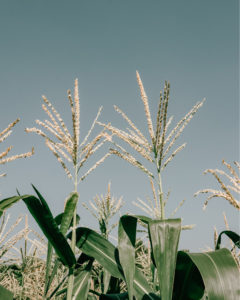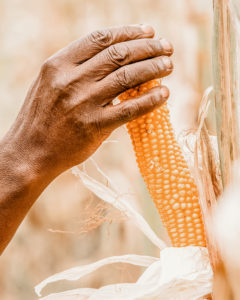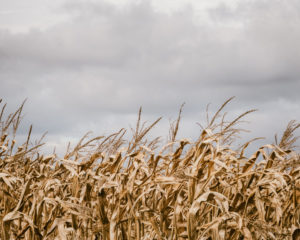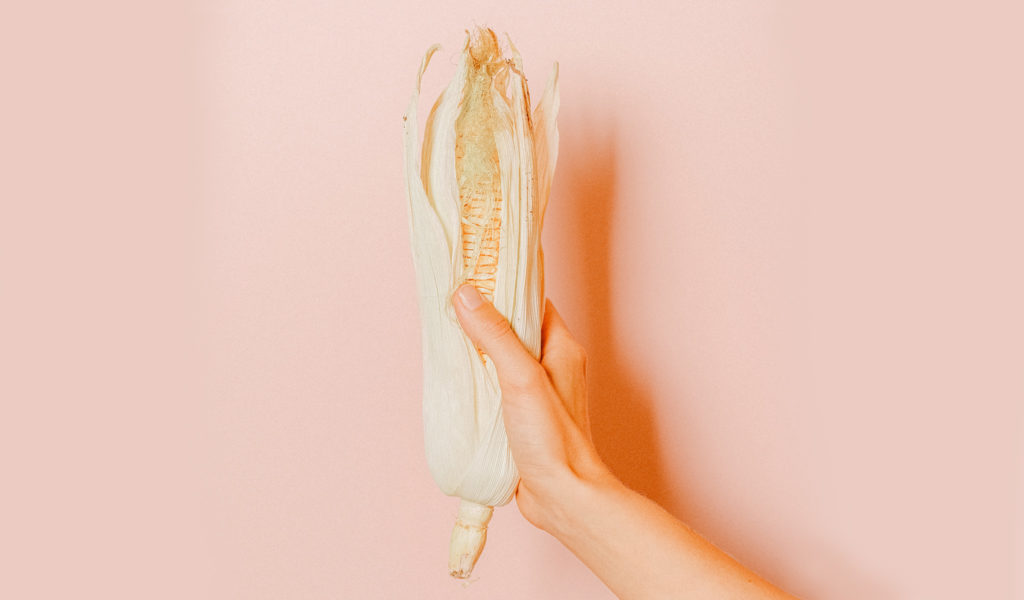The environmental consequences of our global reliance on fossil fuel-derived plastics are well documented—the ongoing pollution of our oceans and endangerment of aquatic life, the greenhouse gas emissions of the 91% of plastic that ends up in landfill, and of course the colossal energy spent in extracting this finite resource from the earth in the first place.
In response manufacturers are increasingly turning to plastic alternatives to cut the cord to petroleum. This includes what are called bioplastics; plastics made from natural materials rather than petroleum. And although cornstarch may bring to mind home baking and gravy before anything else, its application as a sustainable input for bioplastics has gained traction in recent decades.
Bioplastics made from cornstarch can be harnessed to diverse uses such as product packaging, disposable cutlery, and other soft and hard plastic goods. The fact that the resultant material is biodegradable and carbon neutral has earned it plenty of eco-friendly plaudits. However, when we think about cornstarch sustainability, we must consider the whole lifecycle of a product to understand its impact on the planet. Cornstarch has uses beyond bioplastics too, some of which may yet prove to be more sustainable applications.
What is Cornstarch?
Cornstarch is derived from the corn crop, also known as maize, which is the most grown cereal crop in the world. The US is the world’s biggest maize producer by some way, generating almost a third of the globe’s corn. Most of the yield in this country is used as livestock feed for cattle, hogs, and poultry, or converted into ethanol for use in renewable fuel. Despite the market share of biofuel, here we will focus on corn’s use in manufacturing bioplastics as one of the most promising applications of the material for the future.
Converting Corn into Plastic
The process of obtaining cornstarch for bioplastics begins by soaking corn kernels in hot water and sulfur dioxide. This breaks them down into protein, fiber, and starch. Next the kernels are ground up and the starch is extracted from the corn oil. The resultant cornstarch is then most commonly transformed into a bioplastic called Polylactic Acid (PLA), one of the two main bioplastics in the field. The cornstarch is composed of chains of carbon molecules, to which citric acids are added to form a long chain polymer, giving us the basic unit for the manufacture of plastic.
PLA acid is as flexible in use as petroleum-based plastic and can be harnessed to make cornstarch sustainable products that stand up to conventional plastic materials such as polystyrene (e.g. as in disposable cups, plates and bowls), polythene (e.g. as used for plastic bags and bottles), and polypropylene (e.g. as used in injection molding for hard plastic products like car battery casings or outdoor furniture).
Is Cornstarch a Sustainable Material?
PLA made from cornstarch is biodegradable, carbon neutral and even edible. Because cornstarch is biodegradable (under the right circumstances) it can be composted and returned to the soil to imbue it with nutrients. Any carbon emissions released during biodegradation are effectively canceled out by the carbon that was captured during the plant’s growth phase.
Corn can also be considered a renewable material in the sense that it can be replanted ad infinitum, unlike fossil fuels. When corn is farmed sustainably and the ensuing cornstarch products are composted correctly at the end of their lives, it certainly seems to function as a sustainable raw material.
However, optimal farming conditions are not widespread and there are a number of biodiversity concerns around corn crops in the US. Cornstarch is often derived from genetically modified corn which has a directly negative impact on biodiversity and an indirect impact on human bodies (via livestock feed), the consequences of which are still uncertain. The high quantities of fertilizer and pesticides used to raise corn and ensure high yields also hampers biodiversity, particularly as regards the nitrogen in corn fertilizers, which has a high leakage factor in surrounding soil.
Along with fertilizers, the various chemicals used in converting cornstarch into PLA means the production process creates greater amounts of pollutants than regular plastics. These methods persist due to their cost effectiveness. However, developments to make corn farming more eco-friendly are underway, including strategies such as corn-soybean crop rotation and controlled drainage.
Because the biodegradation of cornstarch plastics at their end of life requires specific, industrial conditions, many US cities do not boast the infrastructure to carry out PLA composting at all. As a result, a huge proportion of PLA plastic simply ends up in landfill. Once there, deprived of oxygen, it will emit methane, a potent greenhouse gas (GHG) with an outsized contribution to climate change.
Another thorn in the side of proper PLA disposal is the contamination of conventional plastic recycling streams with PLA. This occurs far too frequently as a result of consumer confusion about what bioplastics actually are and how they differ from fossil fuel-derived plastics. In practice, this means an entire batch of salvaged, recyclable plastic could be rendered useless and sent to landfill if PLA is accidentally tossed in with it by a consumer.
Is Cornstarch More Sustainable Than the Alternative?
Over its entire lifecycle, cornstarch PLA is more environmentally friendly than fossil fuel-derived plastic because of the lower GHG emissions. However, it’s a closer run thing that some would care to admit. One recent study found that a 25% decrease in GHG emissions could be achieved if we switched from regular plastic to cornstarch PLA. And yet further findings determined that a superior 50-75% decrease in GHG could be obtained if regular plastics were simply made with renewable energy sources. This casts the proud gains of cornstarch bioplastics in a somewhat less flattering light. The solution posits itself; we must use as much renewable energy in the manufacture of bioplastics as possible.
It is also important to remember that even disposables made from plastic alternatives should be eschewed when reusable materials are available instead. So while bioplastic packaging may be enjoying a moment in the spotlight, and constitute a lower impact than regular plastic over its life, commentators still assert that reusable packaging should be deployed instead of compostable packaging whenever possible.
What Are the Benefits of Cornstarch?
Cornstarch offers several important benefits as a sustainable material as compared to regular plastics.
Carbon Neutral
- Cornstarch production has low net emissions as a result of the carbon consumed by the corn plant while growing, making it a net carbon-neutral material.
Renewable
- Cornstarch is a renewable raw material, as opposed to fossil fuel-derived petroleum, it can be replaced in the ground again and again. If the farming and processing practices around corn production can be developed to reduce its environmental externalities, it can be a far preferable input for plastic production, as opposed to the marginal one it is currently.
Biodegradable
- Cornstarch’s great advantage over regular plastic is that it is biodegradable in as little as 90 days under the right conditions.
Food Safe
- Cornstarch plastic is FDA approved as 100% safe food packaging resistant to oily foods, making it a great alternative to conventional plastic packaging in restaurant takeaways or similar. Biodegradable packaging is expected to represent a $121 billion industry by 2025.
Non-Toxic
- Bioplastics made from cornstarch do not release any harmful toxins when they biodegrade. It is also absent of n bisphenol A (BPA), a hormone disrupter that conventional plastics usually contain.
What Are the Disadvantages Of Cornstarch?
Although cornstarch is compostable, the glaring caveat to all the avid marketing of cornstarch goods is that they can only be composted at industrial facilities and not at home. This is because composting cornstarch requires higher heats (140 degrees Fahrenheit) than home composting setups can achieve, as well as the presence of specific microbes to encourage the process.
Why is this a disadvantage? Because that process is not only far less likely to occur when we take into account national recycling rates in the US (only 9% of plastic is recycled), plus the process consumes additional energy in and of itself. For example, in the operation of specialist machinery and the wider waste management infrastructure required to collect and manage it. Another drawback is that the output of compost is not ready for use right away. In fact, it is so acidic that it requires expensive alkaline treatment before it is safe for soil.
The use of corn in bioplastics and indeed biofuel has other unintended consequences, such as detracting from the plant’s use as a food crop. Some populations around the world rely on corn for food supply and it is possible that an increase in demand for corn for bioplastics could contribute to the global food crisis.
Because of the complex processing stages for cornstarch, PLA can be expensive to produce; around 20 – 50% more than traditional plastics. However, gains are being made to improve the production process and narrow that gap.
How Else Can Cornstarch Be Used?
Though much touted for its use in bioplastics, cornstarch has the properties to replace other conventional materials too, as well as some useful, time-honored domestic applications.
- Biofuel
Cornstarch-based ethanol as an alternative to gasoline is the second biggest use for corn crops in the US today (the largest being livestock feed). But in recent years this once revolutionary application of corn has come under fresh scrutiny and some worrying conclusions have been drawn. The corollary to the massive US increase in corn production to meet biofuel demand is resultant GHG emissions at least equivalent to gasoline use, and likely 24% higher. The future for cornstarch-based biofuel has been on shaky ground since these findings came out.
- CoRncrete
A novel material intended as a game changer for the construction industry, CoRncrete, which consists of cornstarch in combination with sand and water, is showing promise as an alternative to traditional concrete. The mixture can be molded and then heated to provoke gelatinization. The end material has a compressive strength high enough for light-traffic roads and driveways.
- Microbial Fuel Cells
Microbial fuel cells use microbes and bacterial activity in industrial effluent to generate green energy. A project undertaken recently in Nigeria applied cornstarch waste water to microbial fuel cells to great effect.
- Household Cleaning
Cornstarch has long been used as a handy cleaning solution to get out stains from clothes and carpets. As such it constitutes a natural alternative to conventional, chemical-based cleaning products.
- Stabilizer
Recent innovations show that cornstarch can be combined with vegetable oil to create a useful stabilizer for use in products such as paints, glues and cleaners as alternatives to petroleum oil, thus allowing similar products to bear a smaller environmental impact.
The sustainability credentials of cornstarch are far from black and white. Bioplastics and other so-called sustainable materials are only as green as their processes. While the crop is indeed renewable, the farming practices and biodiversity implications that accompany its proliferation in recent years muddy the water. While further on in the life cycle, the inconsistent composting of PLA has as yet unquantified impacts on the industry’s GHG emissions.
For cornstarch plastics to be truly sustainable, proper disposal processes must be put in place throughout the country. In the meantime, bioplastics and the appendant products are a valuable step away from petroleum-based plastics.
Visit the zero waste blog for more tips and guides on going zero waste, or check out the shop to see what sorts of products are making clever use of zero-waste raw materials.

